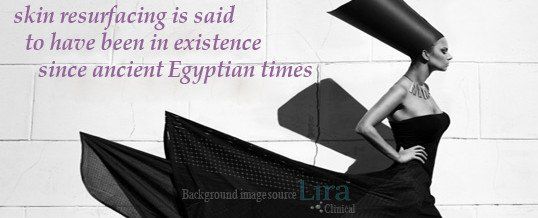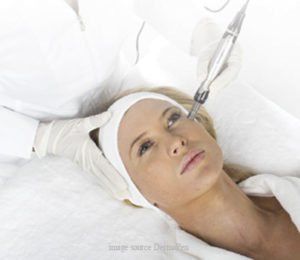MicroNeedling ~ A Non-surgical Collagen Booster
- By J.Maxine MacGwyre, LMA, Nutrition Specialist
- •
- 17 May, 2019
- •

Collagen Stimulation Therapy also known as MicroNeedling is quickly becoming one of the most popular procedures for skin resurfacing, despite the initial shock value of a skincare treatment involving needles. Why? Because this treatment is proving highly valuable in its ability to improve the appearance of fine lines, acne scars and the overall appearance of the skin.
A study¹ of 480 patients treated over a 10-year period of time showed a 60–80% increase in collagen and elastin, as well as a 40% thickening of the stratum spinosum—the epidermis’ spinous layer or prickle cell layer. With results like these, MicroNeedling is truly a game changer.
MicroNeedling History
According to history, skin resurfacing is said to have been in existence² since ancient Egyptian times. While clearly the methods available to the early Egyptians were primitive in comparison to modern times; historians claim acids, sandpaper and other materials made from minerals and plants were used exfoliate (slough off) layers of the skin. Some of the first forms of controlled resurfacing abrasion of the skin appeared in the early 1900s when a German dermatologist used rotating wheels and rasps to treat acne scars, keratosis and hyperpigmentation…yipes!
It wasn’t until the middle of the century when numerous research articles on efficacy and technique began to appear, that skin abrasion procedures didn’t start to pick up steam. This research resulted in making skin resurfacing a more viable mainstream practice in the medical community.
In 1995, Subcision, an early form of MicroNeedling, was introduced. Subcision used a tri-beveled hypodermic needle to reach the tissue under depressed scars, wrinkles and contours in the skin, to create a controlled trauma to the skin, which then initiated healing of the area² This procedure spurred the development of additional techniques, which eventually developed into the more sophisticated process of MicroNeedling. First with rollers, then medical devices referred to as “pens”.
What is MicroNeedling?
The non-surgical treatment known as MicroNeedling involves using tiny needles to create micro-injuries into the dermo-epidermal junction.

These precise perforations create very controlled wounding, when a pen is used the micro-injuries are performed at 90-degree angles. This controlled wounding of the skin initiates the inflammation response, and in turn activates the healing cascade which among other cellular processes, stimulates fibroblasts (a type of cell) to produce collagen and elastin as the skin repairs itself. New, healthy tissue surrounds the wounded area, thereby rejuvenating the skin and in effect turning back the hands of time. Another benefit of MicroNeedling, not to be overlooked, is its ability to allow other skin-building ingredients to more efficiently penetrate the skin, where they can affect cells at deeper levels. Enhancing penetration of Vitamin C, Hyaluronic Acid and skin lighteners such as Kojic Acid make MicroNeedling an excellent treatment for aging and hyperpigmented skin.
Another application for MicroNeedling is the treatment of melasma. Since heat, from laser treatments, can actually worsen Melasma, MicroNeedling is the go-to for addressing this type of skin condition.
Microneedling in the treatment room
MicroNeedling is becoming more popular as clients look to more cost-effective skin-resurfacing alternatives that don’t require much downtime. MicroNeedling’s laser treatment equivalent is a fractional laser which has a typical downtime post-treatment of 5 days. Downtown with MicroNeedling does not normally exceed 24 hours and any “pinkness” can be covered up quite effectively with an approved post treatment tinted SPF product such as Lira Clinical BB Crème. Price point wise a typical fraction laser is $1500 and a series of 3 is often recommended. The average price for a MicroNeedling treatment is in the $300-500 range; 3-6 treatments are recommended depending on the client’s skincare goals.
Clients often see positive results after their first procedure, and may return every four to six weeks until the desired goal is achieved.
MicroNeedling Boosters
Since MicroNeedling supports optimal penetration of ingredients such as Hyaluronic Acid, Vitamin C, and Epidermal Growth Factors applied just prior, during or post treatment will deliver hydration, and work to fortify, rebuild and heal the skin.
The effects of MicroNeedling are also boosted with the proper home care before and after the client’s appointment. Depending on skin type and desired outcomes, Enzymes, Alpha Hydroxy Acids (like Lactic Acid) and Retinols may be used prior to the treatment to prepare the skin and deepen the healing and rejuvenation.
Post treatment, clients should expect some “pinkness” and minimal swelling, which typically dissipates within 24 hours and tells us that the inflammation response has been activated which is the desired result. This, however, also means proper post-care support is imperative which includes use of a resting Cleanser, Vitamin C, Peptides, light hydration and mineral based SPF 30.
As MicroNeedling continues to grow in popularity, it will behoove consumers to do their research as to the qualifications of their practitioners. MicroNeedling is an advanced service not taught in aesthetics school, special advanced coursework is required to perform this service. Additionally, in the state of Arizona, Aestheticians are NOT required to complete continuing education coursework. This treatment will yield amazing results in the hands of a trained, experienced Aesthetics professional.
REFERENCES
1. MC Aust, D Fernandes, P Kolokythas, et. al. Percutaneous collagen induction therapy: an alternative treatment for scars, wrinkles, and skin laxity, Plast Reconstr Surg 121 4 1421–9 (2008)
2. www. microneedle. com/ main/ history. html




